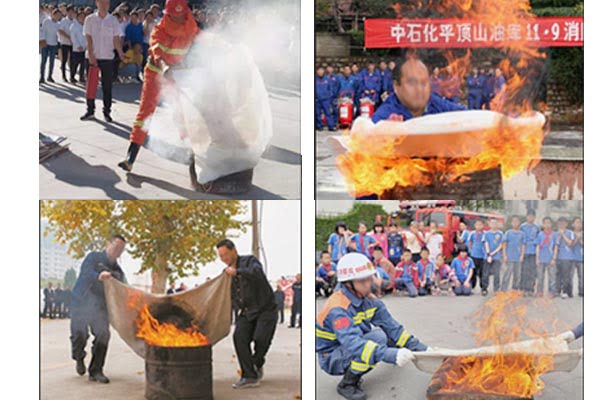
In a world where fire incidents can cause devastating consequences, it is crucial to prioritize fire safety and prevention. Whether it's in our homes, workplaces, or public spaces, understanding the risks associated with fire and implementing effective safety measures can save lives and protect valuable assets. In this comprehensive guide, we will delve into the world of fire safety, exploring various aspects such as fire prevention, emergency preparedness, and the importance of fire safety training. So, let's ignite our knowledge and become flame-fighters in our own right!
Fire is a chemical reaction that occurs when three elements come together: heat, fuel, and oxygen. This phenomenon, known as the fire triangle, is the foundation of fire science. Moreover, understanding how fire spreads and behaves is essential for effective fire safety and prevention strategies. Additionally, by comprehending the different classes of fire and their extinguishing methods, we can better equip ourselves to combat fire emergencies.
Preventing fires is always better than dealing with their consequences. Consequently, fire prevention involves identifying potential fire hazards, implementing safety measures, and promoting fire safety awareness. From practicing proper electrical safety to maintaining fire-resistant materials, there are numerous steps we can take to minimize the risk of fire incidents. Furthermore, by adopting a proactive approach, we can significantly reduce the likelihood of fires occurring.
Our homes should be a sanctuary, free from the threat of fire. Implementing fire safety measures at home is crucial to protect our loved ones and our valuable possessions. This section will explore essential fire safety tips for residential properties, including installing smoke detectors, creating escape plans, and ensuring proper storage and handling of flammable materials. By following these guidelines, we can create a safe and secure environment for our families.
Workplaces are not immune to fire hazards, and employers have a responsibility to prioritize the safety and well-being of their employees. This section will discuss the importance of fire safety protocols in the workplace, including conducting fire risk assessments, establishing evacuation plans, and implementing fire safety training programs. By fostering a culture of fire safety in the workplace, employers can protect their workforce and minimize the potential for fire-related accidents.
Public spaces, such as schools, shopping malls, and entertainment venues, cater to a large number of people daily. Ensuring fire safety in these areas is paramount to protect the public and prevent disasters. This section will explore fire safety measures for public spaces, including proper exit signage, fire suppression systems, and crowd management strategies. By implementing these measures, we can create a secure environment for everyone.
No matter how well we prepare, emergencies can still occur. Being prepared for fire emergencies is crucial to minimize damage and ensure the safety of individuals. This section will discuss the importance of emergency preparedness, including creating emergency kits, conducting fire drills, and staying informed about local emergency services. By being ready for the unexpected, we can effectively respond to fire incidents and protect ourselves and others.
Knowledge is power, especially when it comes to fire safety. This section will emphasize the importance of fire safety training for individuals of all ages. From basic fire safety awareness to advanced training in fire extinguisher usage and evacuation techniques, acquiring the necessary skills can make a significant difference during fire emergencies. By investing in fire safety training, we can become confident flame-fighters capable of handling fire incidents effectively.
Fire safety equipment plays a vital role in mitigating fire risks and ensuring the safety of individuals. This section will explore essential fire safety equipment, including fire extinguishers, smoke detectors, fire alarms, and sprinkler systems. Understanding the different types of equipment and their proper usage is crucial for effective fire prevention and response. By equipping ourselves with the right tools, we can enhance our fire safety measures.
Fire safety regulations are in place to ensure that individuals and organizations adhere tostandards that minimize the risk of fire. In this section, we will delve into the legal framework surrounding fire safety, including national and local regulations, building codes, and compliance requirements. Understanding and complying with these regulations is not only a legal obligation but also a moral one, as it ensures the well-being of all individuals affected by fire risks. We will also discuss the potential consequences of non-compliance, which can range from fines to more severe legal actions.
Navigating the complexities of fire safety can often lead to questions. In this section, we will address some of the most frequently asked questions related to fire safety and prevention. By providing clear and concise answers, we aim to dispel common misconceptions and empower individuals with accurate information. Whether you're curious about the best type of smoke detector for your home or how to conduct a fire safety audit, this FAQ will serve as a valuable resource.
Fire safety is a critical aspect of maintaining a secure and safe environment for ourselves and those around us. By understanding fire hazards, implementing preventative measures, and preparing for emergencies, we can significantly reduce the risk of fire and its potentially catastrophic consequences. We encourage everyone to take fire safety seriously and to continuously seek out knowledge and resources to enhance their fire safety practices. Remember, when it comes to fire safety, complacency is not an option. Let's work together to keep the flames of danger at bay and foster a culture of safety and prevention.
Fire safety is a shared responsibility, and through collective effort and vigilance, we can create safer communities for everyone. Stay informed, stay prepared, and stay safe.
FlameFighter website: https://flame-fighter.com/
